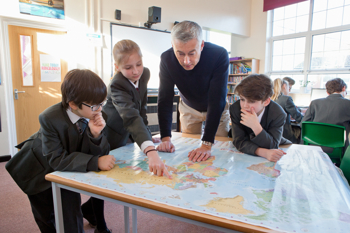
Intent
The Intent of your Key Stage 3 Curriculum can be articulated through detailed Curriculum Maps or Plans. Your Curriculum Maps should include details such as lesson titles, intended learning outcomes, key geographical vocabulary, and essential geographical skills.
It's essential for the entire department to adhere to the Curriculum Map as it ensures consistency and alignment in teaching practices.
Consider how the Key Stage 3 Curriculum addresses gaps in knowledge from Key Stage 2 to ensure a smooth transition and prepares students with the necessary foundation for advanced study at the GCSE level. For example, many students often arrive in Year 7 with little or no experience of sophisticated Ordnance Survey (OS) map skills from primary school. Therefore, starting with OS map skills in the Y7 Curriculum can address these gaps early and lay the foundations for the base of Geography.
However, OS map skills should not just be a stand-alone unit in Year 7. These skills should be continually revisited within the curriculum where relevant or as recap starters where less relevant.
Consider sequence of topics
When planning your curriculum, it's essential to consider the sequence of topics. Ask yourself, 'What do we teach? When and why?' A logical sequence for these topics would be Glaciers followed by Rivers and then Coasts. Glaciers generally occur in mountainous areas, where the ice melts and the water then moves through rivers. Furthermore, considering the temporal aspect, glaciers in the UK are a thing of the past, whereas river and coastal landscapes are within the present and future, making them more relevant for students to study.
Labelling topics
Some schools give short and basic names to their topics like ‘Glaciers’ and ‘Development’. Consider wording the topic titles as questions or bold statements to increase student engagement and curiosity.
For example, ‘How does ice change the World?’ or ‘Africa is NOT a country!’
A successful KS3 Curriculum should combine physical and human aspects of Geography rather than seeing them as standalone entities.
For example, when studying glacial processes and landforms as physical geography, teachers and students could also explore the use of glacial environments and impact of tourism in these areas as human geography.
Implementation
The implementation of the curriculum involves planning activities to help students learn new knowledge and skills. Aim to experiment with different activities for maximum engagement and not simply have students copy from the board or textbook all the time (although sometimes this is necessary).
Geography teachers play a vital role in developing students’ literacy and love of reading. Activities such as guided reading of engaging articles can help when evaluating issues and practicing decision-making skills. Diamond 9 activities get students thinking about ranking importance and effectiveness.
Geography, as a subject, has the potential to inspire and should create a sense of awe and wonder. Select clips from geographical documentaries to help students visually explore the wider world.
Finally, but perhaps most importantly, KS3 Geography should include regular Fieldwork investigations and Geographical Information Systems (GIS) threaded through the curriculum. Organizing field trips for large groups of students can sometimes pose logistical challenges for KS3 Fieldwork; however, effective investigations can still take place within the school grounds. For example, a fieldwork investigation could involve identifying the optimal location for a wind turbine on the school grounds, or measuring noise pollution using an App.
Another activity could be measuring the infiltration rate of water on different surfaces such as grass, soil, and concrete. Similarly, students should have the opportunity to use computers for hands-on engagement with GIS. 'Teach with GIS' is a great platform for this at Key Stage 3. I strongly recommend exploring this free resource to consider how you can integrate it within your curriculum.
Impact
Just because teachers have taught something, does not mean students have learned it. Regular review sessions and knowledge quizzes should be used as formative assessments to help students retain information in their long-term memory.
An end-of-half-term test that only assesses the current topic fails to address gaps in knowledge and skills from previous half-terms or years. Summative assessments should build upon prior learning, ensuring that assessments in Year 9 evaluate knowledge and skills acquired in Year 7.
Exciting News for Key Stage 3 Geography Teachers!
GCSEPod is proud to launch new Geography content designed to bridge the gap between Key Stage 3 and GCSE. This expansion, available to existing KS3 subscribers, offers a comprehensive learning experience with engaging tasks, interactive pods, assessments, and mastery content.
Equipping Students for Success in KS4 Geography
This new resource prepares students for both core and optional GCSE Geography subjects. Engaging tasks can be completed before or during the summer holidays, giving students a valuable head start on Year 10 content. Additionally, Year 9 students can use this alongside in-class taster experiences, empowering them to make informed GCSE subject choices.
Seamless Transition for Teachers and Students
This launch reflects our commitment to a full suite of resources across 30+ GCSE subjects, with continually refreshed content where Key Stage 3 subjects are also available. Current GCSEPod subscribers with the Key Stage 3 package will automatically receive access to these new Geography resources, ensuring a smooth transition for both teachers and students.
To find out more, please visit our product page.

 AU & NZ
AU & NZ
 SG
SG
 MY
MY
 US
US
 IE
IE